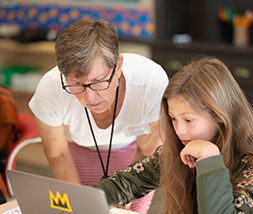Faculty Feature SPRING ’25
Fire and Foundations: A Journey Through Hawai‘i’sGeology and Heritage
By Science Faculty Ken Schopf
I have taught about volcanoes and volcanism for about 25 years. They are an integral part of the system that maintains the earth’s steady-state between the destruction and creation of its crust. I vividly remember the grey veneer of volcanic dust that was a curiosity to us kids in Cleveland when Mount St. Helens erupted in 1980, some 2,500 miles away. I have mapped the black volcanic intrusions on Mount Desert Island in Maine.
And I have seen the shocked looks on the faces of Winsor students on field trips to see the 600-million-year-old lava flows hidden in the forests of Newton’s own Hammond Pond Reservation. But I had never seen an active—or recently active—volcano. This past summer, a Virginia Wing Grant changed all that.
The Hawai‘i Islands hold obvious attraction for vacationers, but for a geologist it offers a glimpse into the inaccessible inner workings of the earth. The slow crawl of the Pacific tectonic plate over a mantle “hot spot” has resulted in a long string of volcanic islands, some of which are still close enough to this site to have active volcanoes. But Hawai‘i is also a hot spot of biological diversity, climatic micro zones, and an Indigenous culture continuing to thrive in the face of massive challenges.
Geologically, I knew what to expect, but I was overwhelmed by the sheer scale of the omnipresent volcanic features. I saw volcanic beaches of black and green sand, geothermal vents, and massive volcanic mountains. I walked in lava tubes and across acres of barren fields of lava, frozen mid-flow into jagged piles and ropy swirls. The day-long trek through Hawai‘i Volcanoes National Park exploring the major fissures and lava flows from the past 200 years was truly mind-boggling, but just a preview for a personal tour of Fissure 8. This is the site of the 2018 eruption that drained Kilauea’s caldera, inundating 14 square miles of the island and devastating the area of Leilani Estates. Walking across the Mars-like terrain on some of the youngest crust on the planet—some of which was still warm—the giant cinder cone at its heart was a stark reminder of the cost of living on an island that is still actively growing. This event alone added some 900 acres to the island.
I also had the good fortune of visiting with the Deputy Chief of the U.S. Geological Survey’s Hawaiian Volcano Observatory. One of just five such centers in the country, the observatory deploys and monitors a huge variety of sensors across the islands and provides all of its data free online for public (and student) use. During my visit to the observatory, I was also able to ask about the role the Indigenous people of Hawai‘i (many of whom self-identify as Kānaka ‘Ōiwi) in the management of the national park.
The Kūpuna Consultation Group that advises the government on park management is only one example of the ways Hawai‘i’s Indigenous people are striving to maintain a cultural and socioeconomic foothold in a homeland that was annexed by another country (the United States) in 1886. Along with the signs, place names, commonly used Indigenous words, and other examples of Hawaiian language one experiences every day, there is a deeper sense of the tie the Indigenous people have to this land. Students in my Class I Science class might be surprised that most of their towns sit on the site of Indigenous settlements of the original Indigenous people of the Massachusett tribe. In Hawai‘i, this connection is much more apparent in everyday life, despite the forced acclimation of its inhabitants to western culture and their current status as a minority population.
I also observed that movement towards acknowledging and rebuilding these cultural ties are likewise underway in several scientific fields. Imiloa is a program of the University of Hawai‘i at Hilo that brings together astronomers and the Indigenous community. Its A Hua He Inoa effort has helped make Hawai‘i “the first place in the world to weave traditional Indigenous practices into the process of officially naming astronomical discoveries.” Similarly, Hawai‘i has become a leader in using TEK (Traditional Ecological Knowledge) to manage and maintain wildlife, particularly its endangered indigenous species.
From my brief stay, I was humbled and amazed by both the geology of the islands and the resilience of the remarkable culture that formed along with them.
Above: Science Faculty Ken Schopf with petroglyphs in Pu‘uloa (hill of long life), a sacred and awe-inspiring gallery of ki‘i pōhaku (images carved in stone) preserved in Hawai‘i Volcanoes National Park.
Check out more photos from Mr. Schopf’s trip on the following pages, and learn about the Virginia Wing Grant Program for faculty and the new Enrichment Grant Program for staff.
Navigating New Ideas
Each year, full-time members of the faculty are invited to submit proposals for Winsor’s Virginia Wing Grant Program for faculty enrichment. Developed in honor of the school’s fifth director, Miss Virginia Wing, the program is designed to support teachers in a project or experience that is broadening and enriching. Proposals may be submitted for travel, study, and professional development, as well as special projects, and need not be strictly professional, operational, or business-oriented.
This spring, full-time staff have been invited to submit proposals for Winsor’s inaugural Enrichment Grant Program for members of the professional staff. Carrying the same stipulations as the faculty grants, the Enrichment Grant Program offers a unique opportunity for staff to spend some of their vacation time engaged in personal or professional projects of their own design.





